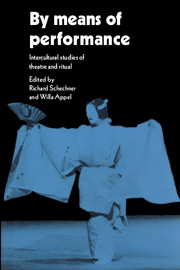Book contents
- Frontmatter
- Contents
- List of figures
- Notes on contributors
- Concerning Victor Turner
- Introduction
- 1 Are there universals of performance in myth, ritual, and drama?
- 2 Magnitudes of performance
- 3 Liminality: a synthesis of subjective and objective experience
- 4 The Yaqui deer dance at Pascua Pueblo, Arizona
- 5 A Yaqui point of view: on Yaqui ceremonies and anthropologists
- 6 Performance of precepts/precepts of performance: Hasidic celebrations of Purim in Brooklyn
- 7 The significance of performance for its audience: an analysis of three Sri Lankan rituals
- 8 What does it mean to “become the character”: power, presence, and transcendence in Asian in-body disciplines of practice
- 9 Korean shamans: role playing through trance possession
- 10 The practice of noh theatre
- 11 The profanation of the sacred in circus clown performances
- 12 Ethnographic notes on sacred and profane performance
- 13 The spatial sense of the sacred in Spanish America and the American South and its tie with performance
- 14 Space and context
- 15 The transformation of consciousness in ritual performances: some thoughts and questions
- 16 Universals of performance; or amortizing play
- Appendix
- Bibliography
- Index
6 - Performance of precepts/precepts of performance: Hasidic celebrations of Purim in Brooklyn
Published online by Cambridge University Press: 05 June 2012
- Frontmatter
- Contents
- List of figures
- Notes on contributors
- Concerning Victor Turner
- Introduction
- 1 Are there universals of performance in myth, ritual, and drama?
- 2 Magnitudes of performance
- 3 Liminality: a synthesis of subjective and objective experience
- 4 The Yaqui deer dance at Pascua Pueblo, Arizona
- 5 A Yaqui point of view: on Yaqui ceremonies and anthropologists
- 6 Performance of precepts/precepts of performance: Hasidic celebrations of Purim in Brooklyn
- 7 The significance of performance for its audience: an analysis of three Sri Lankan rituals
- 8 What does it mean to “become the character”: power, presence, and transcendence in Asian in-body disciplines of practice
- 9 Korean shamans: role playing through trance possession
- 10 The practice of noh theatre
- 11 The profanation of the sacred in circus clown performances
- 12 Ethnographic notes on sacred and profane performance
- 13 The spatial sense of the sacred in Spanish America and the American South and its tie with performance
- 14 Space and context
- 15 The transformation of consciousness in ritual performances: some thoughts and questions
- 16 Universals of performance; or amortizing play
- Appendix
- Bibliography
- Index
Summary
The life of an observant Jew is shaped by the performance of hundreds of precepts. Through ritual elaboration, small and large, the most commonplace acts become deliberate and conscious activities. Special benedictions are recited upon rising, before sleeping, before and after eating, when hearing bad or good news, when seeing lightning or hearing thunder. The createdness of the universe is brought to consciousness again and again, with each ritual acknowledgment of the Almighty and that which he has made, or has made to happen. The performance of precepts thus ritualizes and invests with meaning activities that would otherwise be habituated, taken for granted, or considered trivial.
The performance of precepts also creates events of its own. Each week, month, year, and lifetime, there are special days which acquire their peculiar character through observance of an additional set of precepts prohibiting profane work and enjoining sacred work of specific kinds. About one out of every three or four days in the Jewish calendar is a special day. The variations and contrasts created during special days refreshes the performance of precepts in everyday life.
Hasidism arose in Eastern Europe during the eighteenth century, in part as a reaction against the scholasticism of traditional orthodoxy. As a popular, pietistic, and mystical movement, Hasidism emphasized the expression of devotion through ecstatic prayer, dance, song, narrative, and other means.
- Type
- Chapter
- Information
- By Means of PerformanceIntercultural Studies of Theatre and Ritual, pp. 109 - 117Publisher: Cambridge University PressPrint publication year: 1990
- 2
- Cited by



